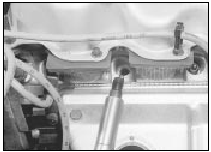Spark plug renewal (Every 12 000 miles (20 000 km) or 12 months)
1 The correct functioning of the spark plugs is vital for the correct running and efficiency of the engine. It is essential that the plugs fitted are appropriate for the engine.
2 Make sure that the ignition is switched off before inspecting the HT leads to see if they carry their cylinder numbers. Note that the position of No 1 cylinder HT lead in the distributor cap is marked with either a pip, or a number “1 “.
3 Where necessary, for improved access remove the air cleaner and/or the inlet hose.
4 Disconnect the leads from the plugs by pulling on the connectors, not the leads.
5 On 2.0 litre DOHC carburettor models, the location of the spark plugs and the close proximity of the carburettor makes spark plug access difficult, particularly when removing the plugs from cylinders 2 and 3. It is suggested that a 3/8 inch ratchet drive spark plug socket with rubber insert and long extension bar is used, possibly in conjunction with a universal joint adapter. It is also advisable to disconnect No 3 cylinder HT lead from the distributor first, to allow some slack for disconnection at the spark plug.
6 Clean the area around each spark plug using a small brush, then using a plug spanner (preferably with a rubber insert), unscrew and remove the plugs (see illustration).

20.6 Removing a spark plug - CVH engine
Cover the spark plug holes with a clean rag to prevent the ingress of any foreign matter.
7 Before fitting new spark plugs, check that the threaded connector sleeves are tight. As the plugs incorporate taper seats, make sure that the threads and seats are clean.
8 On DOHC models before refitting the spark plugs, coat their threads with suitable antiseize compound, taking care not to contaminate the electrodes.
9 Screw in the spark plugs by hand, then tighten them to the specified torque. Do not exceed the torque figure.
10 Push the HT leads firmly onto the spark plugs, and where applicable refit the air cleaner and/or inlet hose.
See also:
Waste gate solenoid control valve - removal and refitting
Removal
1 The solenoid control valve is mounted on a
bracket located underneath the ignition
distributor (see illustration).
21.1 Waste gate solenoid control valve location (arrowed)
2 Disconne ...
Rear shock absorbers (Van models) - removal, testing and
refitting
Removal
1 Raise and support the rear of the vehicle on
stands (see “Jacking and Vehicle Support”).
Place a jack beneath the rear axle tube and
just raise it slightly.
2 Disconnect the shock absor ...
Sump - removal and refitting
Warning: A new sump gasket will
be required on refitting, and
suitable sealing compound will
be required to coat the sump and
cylinder block mating faces.
Shims may be required when mating the
e ...
